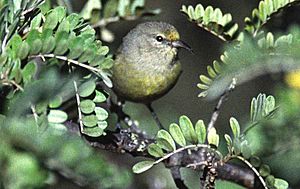Oʻahu ʻamakihi facts for kids
Quick facts for kids Oʻahu ʻamakihi |
|
|---|---|
 |
|
| Conservation status | |
| Scientific classification | |
| Genus: |
Chlorodrepanis
|
| Species: |
flava
|
| Synonyms | |
|
Hemignathus flavus |
|
The Oʻahu ʻamakihi (say: oh-AH-hoo ah-mah-KEE-hee) is a small, colorful bird found only on the island of Oʻahu in Hawaiʻi. It belongs to a special group of birds called Hawaiian honeycreepers, which are part of the finch family.
Male Oʻahu ʻamakihi birds are bright yellow on their undersides. Their upper parts are a greenish color, which stands out against the yellow. Female birds are not as bright. They have two clear stripes on their wings. This bird is about 4.5 inches (11.4 cm) long. It is the only honeycreeper bird that still lives only on Oʻahu.
Contents
About the Oʻahu ʻAmakihi
Naming the Bird
The Oʻahu ʻamakihi was first given its scientific name by Andrew Bloxam. He called it Nectarina flava. Bloxam was a naturalist, someone who studies nature. He saw these birds and collected some on Oʻahu in 1825. He was visiting the Hawaiian Islands on a ship called HMS Blonde.
Later, scientists changed the bird's scientific name. It used to be in the group Hemignathus. Now, it is in the group Chlorodrepanis. This change happened after scientists studied the bird's DNA.
Where the Oʻahu ʻAmakihi Lives
This bird mostly lives in the wetter, southern parts of Oʻahu. You can also find it in valleys near Wahiawa and Mililani. It is easy to spot in places like the Honouliuli Preserve and the Wa'ahila Ridge State Recreation Area.
The Oʻahu ʻamakihi prefers to live in forests. It has learned to live in some forests that have non-native trees. It can even build nests and find food in wooded areas in cities. However, it likes native forests best. These are places where koa (Acacia koa) trees grow a lot. The bird usually lives at heights above 1,650 feet (500 meters). But in some valleys, it can be found at lower elevations.
What the Oʻahu ʻAmakihi Eats
The Oʻahu ʻamakihi has a special bill shape. This bill helps it scrape off pieces of tree bark. It can then reach insects hidden underneath. These insects provide all the protein the bird needs.
The bird also drinks nectar from ʻōhiʻa lehua (Metrosideros polymorpha) trees. Nectar is a sweet liquid found in flowers. Sometimes, if there are no flowers, it will even drink from sugar feeders that people put out.
Reproduction and Life Cycle
Oʻahu ʻamakihi birds find partners during their breeding season. This season runs from mid-December to early March. The female bird builds a small nest, which is about 2 to 4 inches (5 to 10 cm) wide.
She lays one or two eggs. The eggs hatch in about two weeks. The baby birds, called hatchlings, are covered in soft brown down feathers. The young birds are ready to leave the nest about three weeks after they hatch.
Threats to the Oʻahu ʻAmakihi
The Oʻahu ʻamakihi faces several dangers. One big problem is habitat loss. This means their forest homes are being destroyed. Other threats include animals that were brought to Hawaiʻi, like rats or cats, which hunt the birds.
Another danger is avian malaria. This is a disease that affects birds. It is spread by mosquitoes. However, some Oʻahu ʻamakihi populations seem to be able to fight off avian malaria. This might be why they have started to spread into lower areas. Mosquitoes are more common in these lowland places.
Compared to other Hawaiian honeycreepers, the Oʻahu ʻamakihi seems to be doing better. It is listed as "vulnerable," which means it needs protection, but it is not as endangered as some other honeycreeper species.
See also
 In Spanish: Amakihi de Oahu para niños
In Spanish: Amakihi de Oahu para niños


